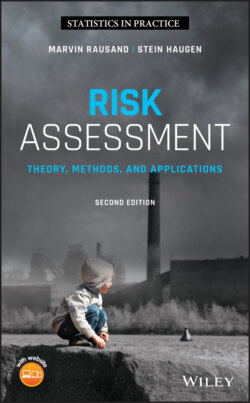Читать книгу Risk Assessment - Marvin Rausand - Страница 263
5.6 Problems
Оглавление1 5.1 Acceptable risk is dependent on context and values. Find examples where there are differences in what risk we accept. Why do you think there are differences?
2 5.2 In discussions about oil exploration offshore, there is often disagreement between environmentalists and oil companies about what the risk and what can be tolerated. Identify reasons why they may have such different opinions.
3 5.3 What are the main differences between the GAMAB and the MEM principle?
4 5.4 Can you think of examples of hazardous activities that we still choose to do because they are useful to us? What is the risk and what are the benefits?
5 5.5 Three “pure” principles of risk acceptance are described in the chapter, equity, utility, and technology. List advantages and disadvantages of each of these principles if we apply just one of them for establishing RAC.
6 5.6 A risk analysis has been performed, and the risk has been calculated at 0.05 fatalities/yr. A risk reduction measure has been proposed and if this is implemented, the risk will be reduced to 0.04 fatalities/yr (20% reduction). The cost of this risk reduction measure is 1 million in investment and 0.2 million in operating costs. The risk reduction measure will have an effect for 20 years. For cost–benefit purposes, VSL is set to 25 million. Perform a cost–benefit analysis and decide if the risk reduction measure has a positive cost–benefit or not.
7 5.7 The results from a risk analysis will always be uncertain to a greater or smaller degree. For the case in the previous problem, the risk analyst has informed us that the initial risk estimate of 0.05 fatalities/yr is uncertain, and that it is likely that the risk is somewhere in the range 0.01–0.08 fatalities/yr. How will this uncertainty affect the results of the cost–benefit analysis (assume that the reduction in risk always is 20%)? What does this tell us about decision‐making based on results from risk analysis?
8 5.8 The precautionary principle is one possible approach to managing risk, particularly aimed at technology and developments that are new and where we do not necessarily know what the risk is. An example of a new technology is autonomous cars and other transport systems. What may the effect be on this type of new technology if we apply the precautionary principle in a strict sense?
9 5.9 Is GAMAB a useful principle for expressing what is acceptable risk if we introduce a completely new technology, e.g. autonomous transport systems? Are we willing to accept the same risk for a new system as an existing one? Find examples where this is not the case.
10 5.10 Consider a system development process and assume that you have identified a particular risk factor. Further, assume that you, based on an evaluation, decide to leave the risk factor as it is without implementing any risk reduction measure. Have you then, in fact, accepted the risk factor?
11 5.11 A new pesticide is proposed, based on a new and unproven mix of chemicals. Discuss the risk related to the introduction of this new pesticide in light of the precautionary principle. Formulate a set of questions to be answered before the pesticide is accepted for use.
12 5.12 List the main strengths and weaknesses of the GAMAB principle.
13 5.13 A company applies the following acceptance criterion for acute pollution events: If no traces or effects of the pollution can be observed five years after the pollution event, it is acceptable. Discuss this principle for acute pollution to the sea (e.g. oil spill).
14 5.14 A hazardous fluid needs to be transported through a densely populated area on a regular basis. Identify factors that need to be considered to decide whether the risk related to this transport is acceptable.
